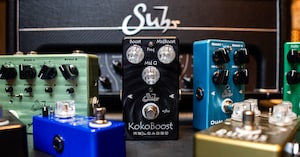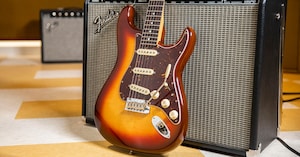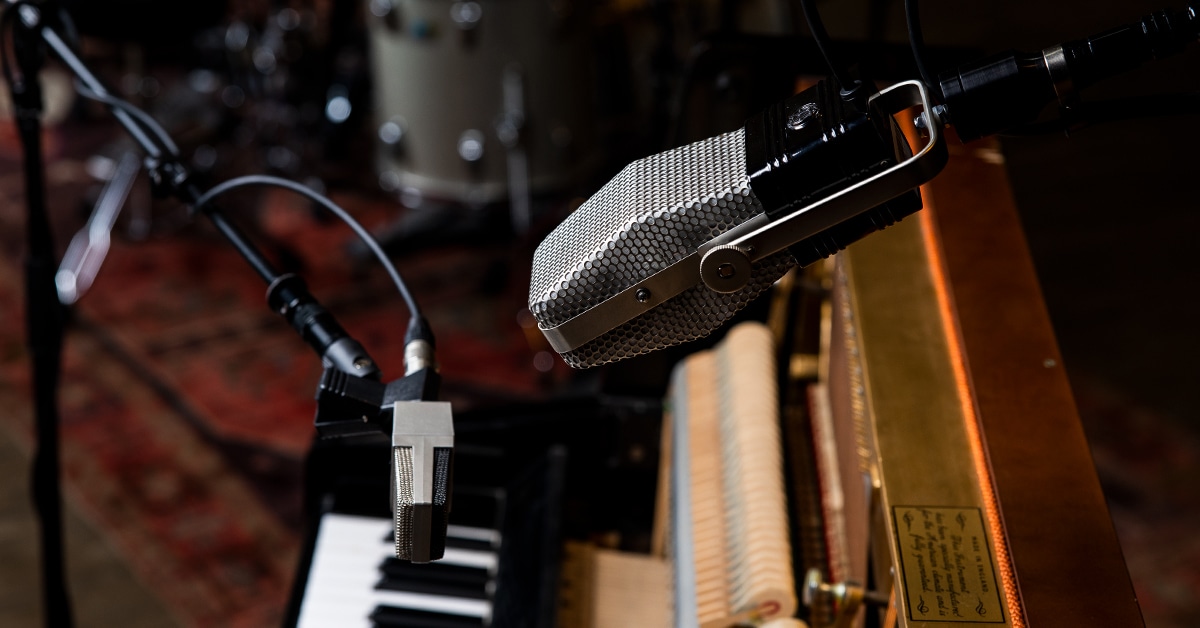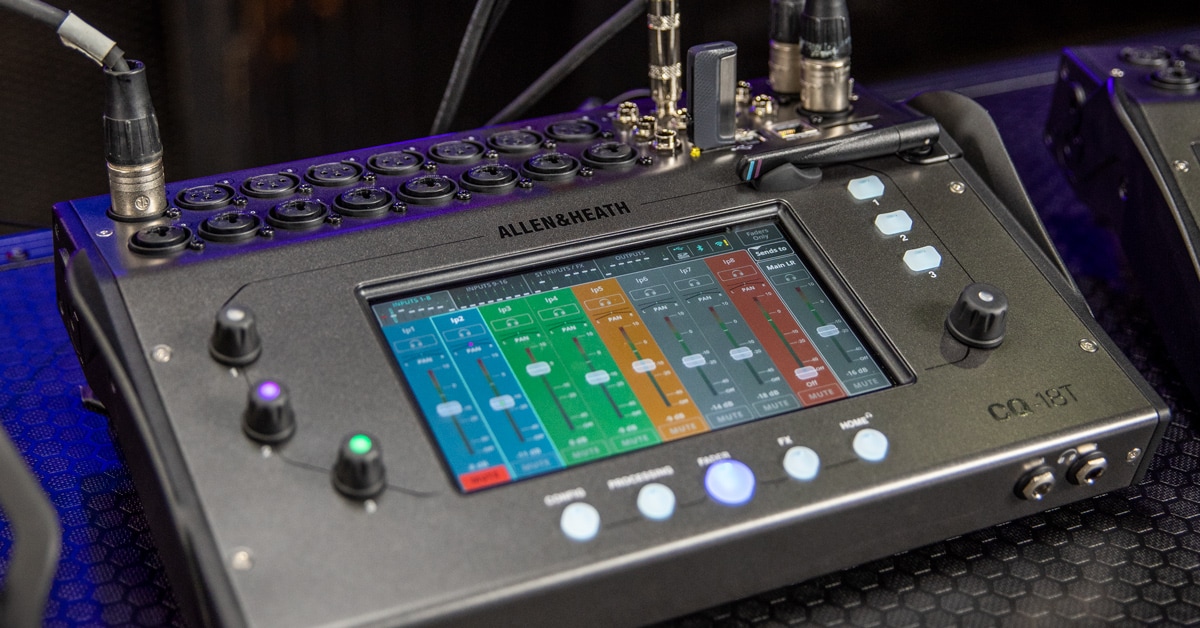Allen & Heath have specially designed their mixers for their clientele since their days of hand-building analog consoles in 1969 London for the likes of The Who, Genesis and Pink Floyd. The CQ series of live mixers is a continuation of this rich tradition—this time catering to the needs of beginning and seasoned engineers alike. Featuring a bevy of forward-thinking, efficient controls, helpful instrument-specific presets and auto gain, plentiful I/O and recording options, as well as patently clever form factors, the hype surrounding the CQ mixers is merited. Take the CQ-12T and CQ-18T mixers, for instance. Their “desktop” chassis is svelte enough to slip into a backpack, while their bountiful inputs and outputs—including Bluetooth connectivity—plus gorgeous touchscreen interface make for a beautifully streamlined mixing experience. And the CQ-20B, with its unassuming stagebox façade, lets you mix from your tablet just as easily as its touchscreen-equipped counterparts, thanks to the same powerful DSP found in the other CQ mixers, as well as onboard Wi-Fi.
We had a word with A&H’s product manager and keen live engineer and general noise maker, Keith Johnson, to discuss the ins and outs—and everything else—of this compelling lineup of mixers.
Can you give our readers some of the backstory on how the CQ Series mixers came about?
Keith Johnson: Well, it actually started quite a long time ago, after we had launched the SQ series. The SQ series took some of the technology that we developed for dLive and shrunk it down into a 48-channel mixer, and we kind of wanted to see how far we could go with some of that technology, and create something that would be suitable for small venues, or that a band could easily carry with them. So, we wanted to design something very portable, and something that might have similar applications to our ZED analog mixers. That meant that we had to think about what the user was going to be like and what they wanted from it. When I say that, I’m not just talking about features or specifications, but also how they would interact with it.
We’ve been doing this for 54 years, we’ve made all kinds of mixers. We've done huge concerts from Pink Floyd to Billie Eilish. I think it was with dLive—which we launched about seven or eight years ago—that we kind of nailed it with digital. And I know a lot of other people think that, as well. It was no longer a case of, “Yeah, analog sounds better and is more fun.” We developed our own processing platform and algorithms. We did everything in-house, and we've then taken that forward into new products since then.
So, CQ was designed for a different user. While something like dLive is perfect for a huge touring show, CQ is for people like myself who are doing smaller gigs a lot of time, where you just need a throw-and-go system to go with your speakers on sticks, but want it to sound great. We were thinking of different corporate uses, too—how it might work as a sub mixer, or in place of an audio interface. So, we spent a lot of time on the processing, but we also spent a lot of time on the UI and some of the tools that we've included. That included things like the Quick Channels, where it's quick and easy to use, but doesn’t feel gimmicky or toy-like. Our goal was to create something that can be used by a pro user, but also something that can be used if you're new to mixing. And to be frank, that’s a lot more difficult than you might think!
Other features that we wanted to include in the CQ range were Bluetooth playback, a built-in Wi-Fi solution with all the benefits of wireless control, all the recording options, etc. We approached it as trying to make something that is a tool, because a mixer is, after all, a creative tool.
How did you settle on the form factor and configurations?
If you are coming from an analog background—let's say small venues or a house of worship situation—you want to have something that's right there. You want that hands- on control so you don’t have to worry about coming in and bringing an iPad. Maybe the people who are using it don't have the knowledge or experience to be messing around trying to connect up stuff. Those users need instant access. So, the CQ-12T and CQ- 18T are the touchscreen models. Our QU and SQ models also have a touchscreen interface, which we’ve seen great success with.
Alternatively, there’s the CQ-20B, which is the stagebox-with-wifi-control version. This is for users who are totally happy mixing on a tablet, so why get a unit with a touchscreen that they're never going to use? CQ-20B is really about throwing it on a stage, plugging everything in and wandering around to make sure it sounds great everywhere. There’s no front-of-house position that limits you to mixing for one static perspective.
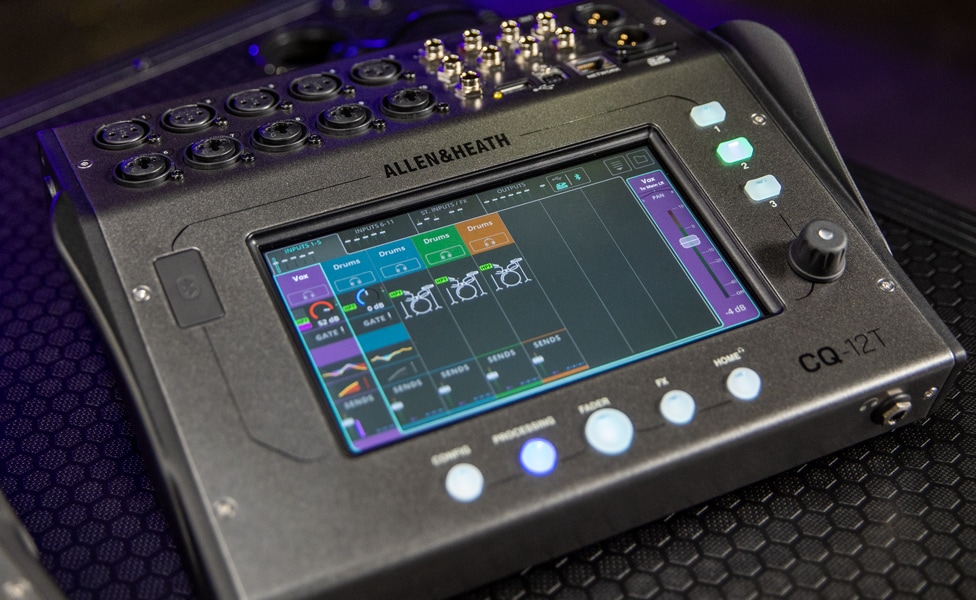
Switching to the touch-based operation, what were the key workflows and functions you knew you really needed to nail?
Well, we’ve tried to make everything as intuitive as possible, but also designed things to work in a similar way. We have self-made rules that we use when we're developing UI and drawing out the GUI. For example, just something simple like moving left to right and top to bottom—which is how the majority of our users work.
You’ll find that the channels work in a similar way to analog channels. They look similar, and signal flow runs from top to bottom. One of our primary goals was to get in and make it nice and easy to use the faders. Like, how do you have faders without faders?
So, we’ve got a whole dedicated fader screen with multitouch for, so you can control it. Our goal was to make something that made sense and could feel like an analog console, with all the benefits of digital.
Working on this project we looked at users who maybe aren’t coming from a live sound or analog background. Some of them are, but not everybody, and a lot of people are now familiar with DAWs and using DAWs. So, we've tried to keep that in mind with how we approached the look and feel of effects, for example—everything from signal flow to how we label what things do and what controls what. If you look at the Quick Channels and a lot of the effects, we’re using GUIs that are kind of more inspired by plug-in GUIs. They're not so technical. They're friendlier and easier to understand and work with.
So, outside of the I/O and total channel count, it seems like the major difference between CQ-12T and CQ-18T are those three knobs.
Yeah, on the CQ-18T we wanted to add some more physical controls. We had space for them because it's, as you've seen, a very compact unit, but when you've got the channel count higher, an XLR connection is an XLR connection, so that really dictates the sizing of the mixer. On the CQ-18T we had some space alongside the screen. We wanted to tie the knobs in with the touchscreen and the whole user experience in UI, and we developed smart rotaries for that. So, what the rotaries control will change depending on which screen you're on. We make it clear on the screen what’s controlling what by using simple colored markers.
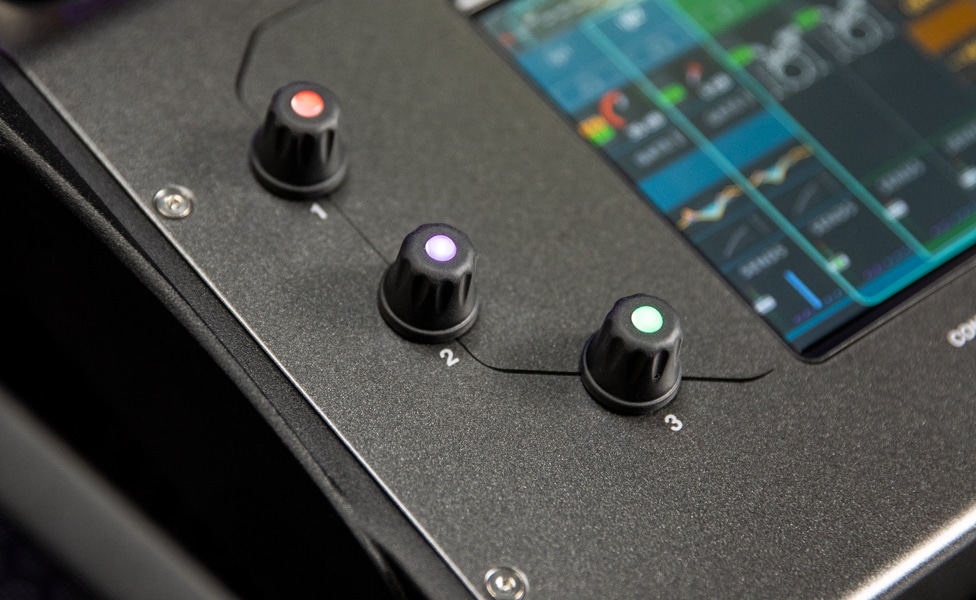
Earlier you mentioned the apps that can be used to control the CQ series mixers, in particular CQ-20B, which doesn’t have a touchscreen. Can you give us some more insight into it?
With the CQ series there are actually two apps. The first is CQ MixPad, which offers users complete control and runs on iOS, Android, PC and Mac. So, if you need to control all of the processing, all of the effects—everything you can control on the unit— that’ll be done with MixPad. You can connect up to two instances of CQ MixPad at a time. As you mentioned with the CQ-20B, it's a necessity because it's how you control the unit. We designed the MixPad app so that the engineer can walk the space and make adjustments.
Where it becomes really useful actually is when you're, say, on monitors because you can go up on the stage, run around with your iPad and set up the monitors right next to the musicians. If you want to give control of those monitors to the musicians, they can use the second app, CQ4UYou, which runs on Android or iOS phones, and with that the musician has control over the levels going just to their individual monitor, controlling oneoutput at a time. That leaves the FOH engineer free to deal with the main mix, and it means they're not shouting at you to make adjustments the whole gig. And you can connect six instances of CQ4UYou—one for each separate output.
Were there any features as you were developing CQ that started as one thing and kind of morphed into another altogether?
Early on, we realized with this product that we had to really think through our effects units. When we started out with that it was like, “Okay, we're going to simplify some of the controls here, and we're going to combine some of the controls.” So if you want to change the size for a reverb, for example, you wouldn’t just change the decay time. You also want to change things like pre-delay. There'll also be changes to the tone and other settings. We wanted to have a really quick, easy-to-use version of some of the effects that we use on our touring-level consoles. So, we kind of pulled apart everything that we had before and looked at them in a completely new way. And then we realized, “Oh, we could actually do something new and interesting here.” That’s what became FX Assist.
We've got a lot of people who contact us and ask things like, “What's the best reverb for a vocal?" Or "What's the best effects unit for X or Y?” So, how can we help those people and make it a little more straightforward for the less-experienced user? We’ve got some ridiculously smart people in that part of R&D who went away and looked at all the different things they could do in the backend dynamically, looking at the signal level and content and just give a really easy one-button sort of solution.
It's kind of funny because all this work that we put into making something simple—it all funnels down. You start off with huge amounts of variables, huge amounts of data and you end up with this single knob that you turn, and it's like, “Oh, does that sound better?”
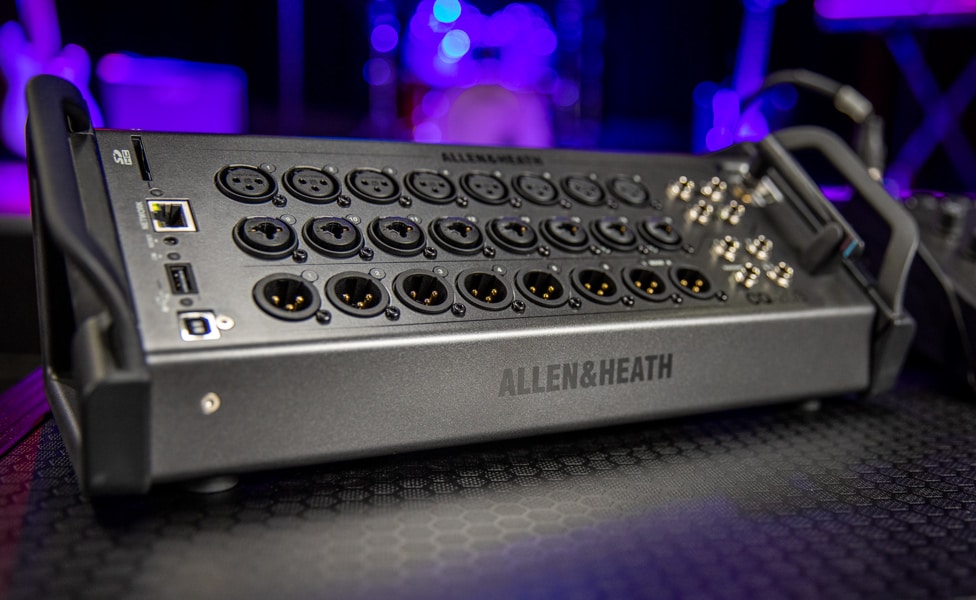
So, CQ has a lot of really great, standout features. Are there any that you think may fly under the radar a bit?
The CQ mixers actually lend themselves to be used in place of audio interfaces, where they can also provide a monitoring solution. Obviously CQ can be used wherever you use a mixer, but with the recording features, they work really well in production spaces.
With the CQ-18T, for example, we put a second headphone out on there, which is independently assignable with individual level. So, you could be in a production environment doing some recording. The engineer's got a set of headphones on. The talent's got a set of headphones on. You can give them a totally separate mix so they hear exactly what they want to hear, and you can be recording a totally clean signal straight off the preamp if you want to mix and produce it later.
And that’s not including all the additional outputs that you have that could be used to feed a monitor mix, right?
That’s right. You've got six independent outputs on each of the three CQ models. For a live event, they might be used for speakers or IEM monitoring, but can also be used for hooking up external gear and effects. So, yeah, that's a cool application for a home studio, particularly at this size and price point. I’ve been using mine for small gigs, but then also for plugging up synths and toys at home when I'm making noise just for me.
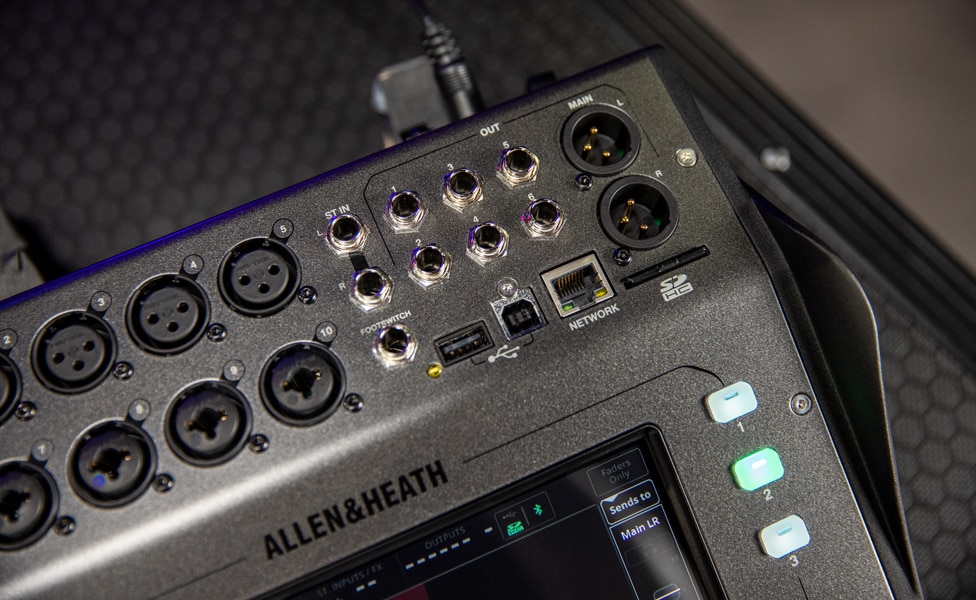
Yeah, and the average audio interface at that price point isn’t also going to have an inline parametric EQ, compressor and/or gate on the recording input.
Exactly. And we've also given the option there, so you can record with all the processing on, or you can record completely clean and you can do your whole mix later. You can record a live show and you can be doing EQ adjustments for that venue or performer, using different effects as need be, but you can be recording that audio completely clean so that you can just take it home and mix it later. That's one of my favorite aspects—that it fits into these different use cases.
Where I see a lot of CQs being used, aside from the band/music production stuff is probably in corporate AV. Because we've got the Automatic Mic Mixer [AMM], it's easy and quick to use and set up. If you're an engineer in a venue where you're doing six meetings or corporate gigs a day, you might have a panel of people talking, you might have an audience mic, and that AMM is going to be really helpful. For any speech applications like that you can rack them up, connect everything and just switch on your AMM.
It really feels like every aspect of CQ series was stemmed from the question “How do we make it easier for users?”
Definitely. And along with the stuff we’ve already talked about, I see a lot of CQs being used in corporate AV and broadcast, too. Because it’s got an Automatic Mic Mixer and the Quick Channels, it's easy and quick to set up and use. So if you're an engineer in a venue where you're doing six meetings or corporate gigs a day—and you might have a panel of people talking and an audience mic, too—AMM is going to make life a lot easier. For any speech applications like that, you can rack them up, connect everything and just switch on your AMM.
The idea that runs through all of our products, but especially with CQ, is that you can get up and mixing really quickly and produce a great sounding mix. The Quick Channels will get you 95 percent of the way there in a fraction of the time it would normally take, and then from there you carry on learning, and you carry on diving in and working out what you want to do and how to do it to get that last 5 percent. That's kind of the point of the whole Quick Channel to Complete Channel Convert feature, which I think is going to be a great education tool. If you've got a single knob, and you turn it and it sounds good you'd be like, “Great! Now let's see what it actually did in the background.” All of that stuff is really cool and makes mixing fun. If you don’t want to be an engineer, it’ll get the job done and sound good. If you do want to be an engineer and go deeper, it can do that, too.
